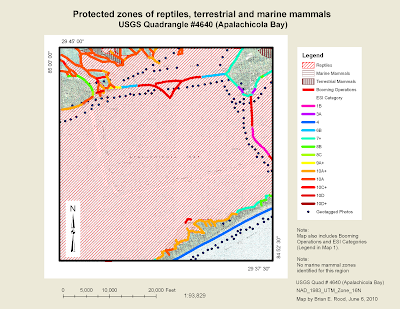The exercise examined the physiography of three Mississippi counties (Hancock, Harrison, and Jackson) and the storm surge that resulted from Hurricane Katrina. After reviewing the metadata for the various layer files in the katrina.gdb geospatial database, the map projections were all based off of the landcover raster layer of the katrina.gdb files. The Environments were set with the current workspace being set as Katrina.gdb and the scratch workspace being set as project1_results.gdb. The Output Coordinate System was set as "Same As Display" and in the Raster Analysis Settings, the Cell size was set to 30 and a Mask was set to the Counties layer from the Katrina geodatabase.
Deliverable 1: Physiographic map of three Mississippi counties
In the first map, the Elevation raster layer was initially calibrated in metric units so the layer was transformed to "US"-units (feet). The color scheme for the resulting transformed Elevation layer was set to a yellow to dark green color ramp.

Deliverables 2 and 3: Map of flooded land of the Mississippi coast after Katrina and a bar graph showing percentage of total flooded land by land-cover type.
The next step was to reclassify the types of landcover types into a smaller number of generalized categories. Once the landcover types were characterized, they were matched with the land area that was affected by the Katrina storm surge (15 ft above sea level). Of the land that was affected by the storm surge, we identified the relative percentages of each landcover type that was affected by the flooding. A table was generated.

Deliverable 4: Map showing infrastructure and health facilities at risk from the storm surge.
The next step was to identify infrastructure (major roadways and railroads), hospitals, and churches in order to identify those constructs that would be affected by another Katrina-like storm surge.

Deliverable 5: Map and table presenting the calculated area (acreage and square miles) that was flooded by the Katrina storm surge
The final map and table show a calculated area in units of acres and square miles that were flooded by the Katrina storm surge. These data were determined for the different land cover types established in Deliverable 2 and 3.
























